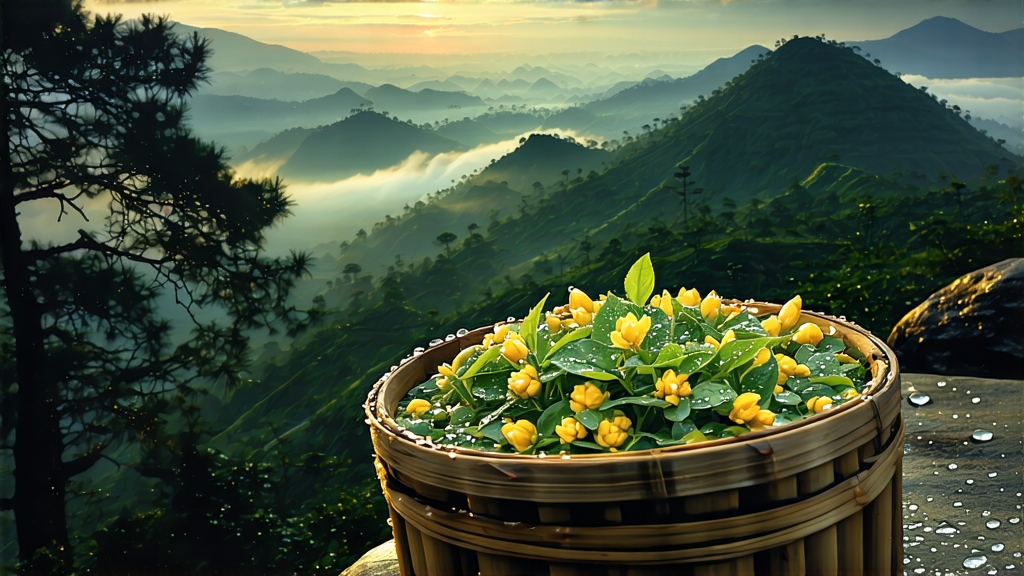
Tucked high above the Sichuan basin, where the Himalayas begin their gentle eastward descent, lies Meng Ding Mountain, a ridge so often cloaked in cloud that poets once called it “the sky’s ink-wash painting.” It is here, among Daoist temples and stone-carved cliff paths, that Meng Ding Huang Ya—literally “Meng Ding Yellow Bud”—has been coaxed into existence for more than twelve centuries. Unlike the better-known green teas of neighbouring hills, this yellow tea survives only in tiny lots, its craft so laborious that fewer than twenty families still master it. To drink it is to taste a vanishing chapter of Chinese imperial history, a flavour that was once reserved for Tang-dynasty emperors and later smuggled along the Tea-Horse Road in exchange for Tibetan warhorses.
Historical scrolls kept at the mountain’s Ganlu Temple record the first offering of “yellow sprouts” to the throne in 724 CE, when a monk presented a small jar of tea that had turned a luminous golden-olive during a freak summer thunderstorm. The emperor, himself a connoisseur, declared the liquor “honeyed yet weightless, like drinking the first light of morning.” Annual tribute followed, and by the Song dynasty the court had fixed the quota at exactly 365 liang—one liang for each day of the year—ensuring that only the most perfect buds were picked. When the Qing turned to darker, compressed teas for their caravans, Meng Ding Huang Ya slipped into obscurity, surviving only through the devotion of hereditary tea makers who refused to let the technique die.
Botanically, the tea belongs to the local Sichuan small-leaf cultivar, Camellia sinensis var. sinensis ‘Ganlu 1’, a slow-growing bush that develops its highest concentration of amino acids at altitudes between 800 and 1 400 m. The mountain’s perpetual fog filters UV light, forcing the plant to produce more theanine and fewer bitter catechins. The result is a bud so tender that experienced pluckers liken it to “a moth’s antennae,” weighing barely 0.05 g yet packed with soluble sugars. Harvest begins on the first day after Qingming, when morning temperatures hover around 12 °C and the dew point keeps moisture on the leaf surface—conditions essential for the enzymatic reactions that will later define yellow tea.
The craft itself is known as men huang—“sealed yellowing”—a five-day choreography that sits between green and black tea making. On the first afternoon, the freshly picked buds are spread on bamboo trays and withered for exactly 90 minutes; every 15 minutes the trays are rotated 180 degrees so that each leaf receives identical exposure. Next comes the sha qing or “kill-green,” but here the wok is cooler (160 °C) than for green tea, and the tossing motion gentler, preserving a residual 8–10 % moisture that would be considered dangerously high in any other genre. While still warm, the buds are wrapped in thick cotton cloths and placed inside a pine-wood cabinet where the temperature is maintained at 28 °C and humidity at 75 %. Over the next 48 hours the leaf ferments micro-aerobically, turning from jade to straw-yellow as chlorophyll breaks down into pheophytin and amino acids condense into unique lactones. On the fourth day the cloth is opened, the leaves re-wok’d at 80 °C to arrest oxidation, then dried in three stages: charcoal baskets (50 °C) for two hours, reed-pan rest for one hour, and finally a 40 °C oven until the moisture falls below 5 %. The entire cycle demands 4 kg of fresh buds—some 16 000 individual tips—to yield a single 500 g parcel of finished tea.
To brew Meng Ding Huang Ya properly one must unlearn the reflexes of green-tea etiquette. The goal is to liberate the honeyed aroma without scalding the delicate enzymes that still linger in the leaf. Start with a tall, thin-walled glass or a porcelain gaiwan of 120 ml; pre-warm it with 80 °C water, then empty. Measure 3 g of dry buds—about two level teaspoons—and let them slide down the inner wall so that they form a loose carpet. Pause for three seconds to admire the colour: an antique gold with faint olive streaks, like silk left in a cedar